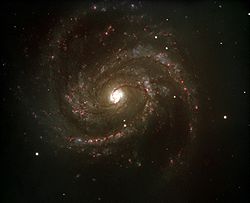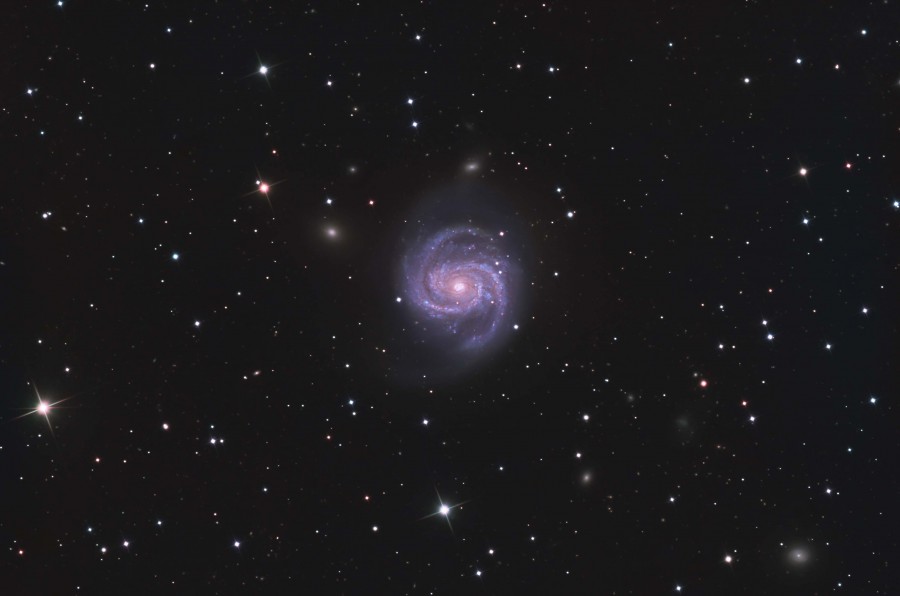m100
Commentaires sur l’objet photographié
 Un peu à la bourre, je traite des images de castor-Sirene de mars dernier !
Un peu à la bourre, je traite des images de castor-Sirene de mars dernier !
Galaxie M100, peu imagée sur le net mais qui vaut le détour, cette galaxie est superbe de détails jusqu’au centre galactique.
Données techniques
Données techniques de prise de vue
Object :M100
Date : du 9 au 24 mars 2011
Optics :Rcos 12″
Mount : Paramount ME Numéro 3
Location : Castor Sirene observatory
Seeing : FWHM de 1,5 à 2,3 arc sec(ccdinspector)
Ccd : Apogee 16803
filter wheel :Apogee
filters : Astrodon LRGB
Focuser :TCC Rcos
Guiding : MMOAG Astrodon et Atik 314L+
Temp. out : -5 °à 5°
Temp ccd : -25°
Total exposure : 21 h
Luminance 66 x 10mn binning 1×1
Rouge 20 x 10 mn bining 1×1
Vert 20 x 10 mn bining 1×1
Bleu 20 x 10 mn bining 1×1
Date : du 9 au 24 mars 2011
Optics :Rcos 12″
Mount : Paramount ME Numéro 3
Location : Castor Sirene observatory
Seeing : FWHM de 1,5 à 2,3 arc sec(ccdinspector)
Ccd : Apogee 16803
filter wheel :Apogee
filters : Astrodon LRGB
Focuser :TCC Rcos
Guiding : MMOAG Astrodon et Atik 314L+
Temp. out : -5 °à 5°
Temp ccd : -25°
Total exposure : 21 h
Luminance 66 x 10mn binning 1×1
Rouge 20 x 10 mn bining 1×1
Vert 20 x 10 mn bining 1×1
Bleu 20 x 10 mn bining 1×1
Données scientifiques
Messier 100 (also known as NGC 4321) is an example of a grand design[4] intermediate spiral galaxy located within the southern part of constellation Coma Berenices. It is one of the brightest and largest galaxies in the Virgo Cluster, located approximately 55 million light-years[3] distant from Earth and has a diameter of 107,000 light years. It was discovered by Pierre Méchain on March 15, 1781 and was subsequently entered in Messier’s catalogue of nebulae and star clusters[5] after Charles Messier[6] made observations of his own on April 13, 1781. The galaxy was one of the first spiral galaxies[6] to be discovered, and was listed as one of fourteen spiral nebulae by Lord William Parsons of Rosse in 1850. Two satellite galaxies[7][8] named NGC 4323 -connected with M100 by a bridge of luminous matter- and NGC 4328 are present within this galaxy.
| Messier 100 | |
|---|---|
 |
|
| Observation data (J2000 epoch) | |
| Constellation | Coma Berenices[1] |
| Right ascension | 12h 22m 54.9s[2] |
| Declination | +15° 49′ 21″[2] |
| Redshift | 1571 ± 1 km/s[2] |
| Distance | 55 Mly[3] |
| Apparent magnitude (V) | 9.5[2] |
| Characteristics | |
| Type | SAB(s)bc[2] |
| Size | 107,000 ly (diameter) |
| Apparent size (V) | 7′.4 × 6′.3[2] |
| Other designations | |
| NGC 4321 | |

